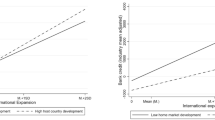Abstract
We use comparable micro level panel data for 14 countries and a set of identically specified empirical models to investigate the relationship between exports and productivity. Our overall results are in line with the big picture that is by now familiar from the literature: exporters are more productive than non-exporters when observed and unobserved heterogeneity is controlled for, and these exporter productivity premia tend to increase with the share of exports in total sales; there is evidence in favour of self-selection of more productive firms into export markets, but nearly no evidence in favour of the learning-by-exporting hypothesis. We document that the exporter premia differ considerably across countries in identically specified empirical models. In a meta-analysis of our results we find, consistent with theoretical predictions, that productivity premia are larger in countries with lower export participation rates, with more restrictive trade policies, lower per capita GDP, less effective government and worse regulatory quality, and in countries exporting to relatively more distant markets.
Similar content being viewed by others
References
Andersson, M. (2007). Entry Costs and Adjustments on the Extensive Margin – An Analysis of How Familiarity Breeds Exports. CESIS Working Paper. Royal Institute of Technology, Stockholm.
Andersson, M., S. Johansson, and H. Lööf (2008). Firm Performance and International Trade: Firm Level Evidence from a Small Open Economy. Review of World Economics/Weltwirtschaftliches Archiv 144 (4): 774–801.
Bartelsman, E. J., and M. Doms (2000). Understanding Productivity: Lessons from Longitudinal Data. Journal of Economic Literature XXXVIII (3): 569–594.
Bernard, A. B., and J. B. Jensen (1995). Exporters, Jobs, and Wages in U.S. Manufacturing: 1976–1987. Brookings Papers on Economic Activity: Microeconomics (1): 67–119.
Bernard, A. B., and J. B. Jensen (1999). Exceptional Exporter Performance: Cause, Effect, or Both? Journal of International Economics 47 (1): 1–25.
Bernard, A. B., and J. B. Jensen (2004a). Exporting and Productivity in the USA. Oxford Review of Economic Policy 20 (3): 343–357.
Bernard, A. B., and J. B. Jensen (2004b). Why Some Firms Export. The Review of Economics and Statistics 86 (2): 561–569.
Bernard, A. B., J. B. Jensen, S. J. Redding, and P. K. Schott (2007). Firms in International Trade. Journal of Economic Perspectives 21 (3): 105–130.
Bernard, A. B., and J. Wagner (1997). Exports and Success in German Manufacturing. Weltwirtschaftliches Archiv/Review of World Economics 133 (1): 134–157.
Damijan, J. P., S. Polanec, and J. Prasnikar (2004). Self-Selection, Export Market Heterogeneity and Productivity Improvements: Firm Level Evidence from Slovenia. LICOS Discussion Paper 148. Katholieke Universiteit Leuven.
Damijan, J. P., and C. Kostevc (2006). Learning-by-Exporting: Continuous Productivity Improvements or Capacity Utilization Effects? Evidence from Slovenian Firms. Review of World Economics/Weltwirtschaftliches Archiv 142 (3): 599–614.
De Loecker, J. (2007). Do Exports Generate Higher Productivity? Evidence from Slovenia. Journal of International Economics 73 (1): 69–98.
Foster, L., J. Haltiwanger, and C. Syverson (2005). Reallocation, Firm Turnover, and Efficiency: Selection on Productivity or Profitability? IZA Discussion Paper 1705. Institute for the Study of Labour, Bonn.
Görg, H., and E. Strobl (2001). Multinational Companies and Productivity Spillovers: A Meta-Analysis. Economic Journal 111 (November): F723–F739.
Greenaway, D., and R. Kneller (2007). Firm Heterogeneity, Exporting and Foreign Direct Investment: A Survey. Economic Journal 117 (February): F134–F161.
Hallward-Driemeier, M., G. Iarossi, and K. L. Sokoloff (2002). Exports and Manufacturing Productivity in East Asia. A Comparative Analysis with Firm-Level Data. NBER Working Paper 8894. National Bureau of Economic Research, Cambridge, Mass.
Helpman, E. (2006). Trade, FDI, and the Organisation of Firms. Journal of Economic Literature XLIV (3): 589–630.
ISGEP (International Study Group on Exports and Productivity) (2007). Exports and Productivity – Comparable Evidence for 14 Countries. Working Paper Series in Economics 65. University of Lüneburg.
Isgut, A., and A. Fernandes (2007). Learning-by-Exporting Effects: Are They for Real? MPRA Paper 3121. University Library of Munich.
Kaufmann, D., A. Kraay, and M. Mastruzzi (2007). Governance Matters V: Governance Indicators for 1996–2006. World Bank Policy Research Working Paper 4280. The World Bank, Washington, D.C.
Lileeva A., and D. Trefler (2007). Improved Access to Foreign Markets Raises Plant-Level Productivity ... for Some Plants. NBER Working Paper 13297. National Bureau of Economic Research, Cambridge, Mass.
López, R. A. (2005). Trade and Growth: Reconciling the Macroeconomic and Microeconomic Evidence. Journal of Economic Surveys 19 (4): 623–648.
Má nez, J. A., M. E. Rochina-Barrachina, and J. A. Sanchis (2008). Sunk Costs Hysteresis in Spanish Manufacturing Exports. Review of World Economics/Weltwirtschaftliches Archiv 144 (2): 272–294.
Mayer, T., and G. I. P. Ottaviano (2007). The Happy Few: The Internationalisation of European Firms. Brussels: Bruegel.
Melitz, M. J. (2003). The Impact of Trade on Intra-Industry Reallocations and Aggregate Industry Productivity. Econometrica 71 (6): 1695–1725.
Melitz, M. J., and G. I. P. Ottaviano (2008). Market Size, Trade, and Productivity. Review of Economic Studies 75 (1): 295–316.
Muûls, M., and M. Pisu (2007). Imports and Exports at the Level of the Firm: Evidence from Belgium. CEP Discussion Paper 801. Centre for Economic Performance, London.
Oulton, N., and M. O’Mahony (1994). Productivity Growth – A Study of British Industry 1954–1986. The National Institute of Economic and Social Research Occasional Papers XLVI. Cambridge: Cambridge University Press.
Rauch, J. E., and J. Watson (2003). Starting Small in an Unfamiliar Environment. International Journal of Industrial Organization 21 (7): 1021–1042.
Serti, F., and C. Tomasi (2008). Self-Selection and Post-Entry Effects of Exports: Evidence from Italian Manufacturing Firms. Review of World Economics/Weltwirtschaftliches Archiv 144 (4): 660–694.
Van Biesebroeck, J. (2005). Exporting Raises Productivity in Sub-Saharan African Manufacturing Firms. Journal of International Economics 67 (2): 373–391.
Van Biesebroeck, J. (2008). The Sensitivity of Productivity Estimates: Revisiting Three Important Productivity Debates. Journal of Business and Economic Statistics 26 (3): 311–328.
Wagner, J. (2007). Exports and Productivity: A Survey of the Evidence from Firm-Level Data. The World Economy 30 (1): 60–82.
Author information
Authors and Affiliations
Corresponding author
Additional information
JEL no.
F14, D21
About this article
Cite this article
(ISGEP), I. Understanding Cross-Country Differences in Exporter Premia: Comparable Evidence for 14 Countries. Rev World Econ 144, 596–635 (2008). https://doi.org/10.1007/s10290-008-0163-y
Issue Date:
DOI: https://doi.org/10.1007/s10290-008-0163-y




